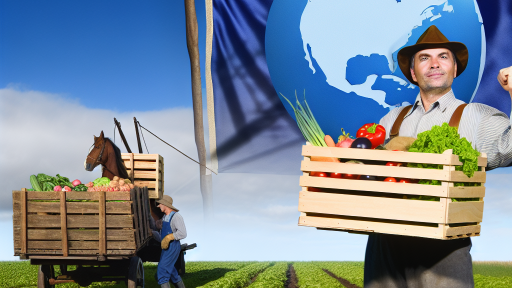Introduction
Farm policies play a crucial role in modern agriculture.
They shape how farmers operate and thrive.
Understanding these policies is essential for success.
Importance of Farm Policies
Farm policies provide the framework for agricultural practices.
They offer guidelines on subsidies, safety regulations, and environmental standards.
Policies ensure fair trade and support sustainable farming.
Impact on Farming Operations
- Financial Support: Policies offer subsidies and grants.
These financial aids help farmers manage costs and invest in improvements. - Regulations and Compliance: Policies set safety and quality standards.
Compliance ensures product safety and avoids legal issues. - Environmental Practices: Policies promote sustainable farming.
They encourage practices that protect soil, water, and biodiversity. - Market Access: Policies influence market access and trade agreements.
They affect how farmers sell their products domestically and internationally. - Risk Management: Policies provide risk management tools.
Insurance and disaster relief support farmers during unpredictable events.
Understanding and following farm policies help farmers optimize their operations.
Stay informed about these regulations to make informed decisions and enhance your farming success.
The Farm Bill
The Farm Bill is a critical piece of legislation that directly impacts farmers across the country.
It is a comprehensive package of laws that governs various aspects of agriculture, nutrition, conservation, and rural development.
Key Provisions
- Subsidies for farmers: The Farm Bill provides financial support to farmers through commodity subsidies, crop insurance, and disaster assistance programs.
- Conservation programs: The bill includes provisions for conservation programs that help farmers implement practices to protect soil, water, and wildlife habitats.
- Nutrition assistance: The Farm Bill also funds programs like the Supplemental Nutrition Assistance Program (SNAP), which provides food assistance to low-income individuals and families.
- Rural development: The bill includes initiatives to support rural communities through infrastructure projects, business development grants, and housing assistance.
Importance of Staying Informed
As a farmer, it is crucial to stay informed about changes to the Farm Bill because these changes can directly impact your operations and bottom line.
By understanding the provisions of the bill, you can take advantage of support programs and resources that can help you succeed.
Moreover, being aware of updates to the Farm Bill allows you to advocate for policies that benefit your farm and the broader agricultural community.
By participating in the legislative process and staying informed, you can help shape the future of agriculture in a way that supports sustainable practices and economic viability.
In fact, the Farm Bill is a foundational piece of legislation that shapes the landscape of American agriculture.
By understanding its key provisions and staying informed about changes, farmers can navigate the complex agricultural environment and take advantage of support programs that can help them thrive.
Crop Insurance Programs
Overview of Crop Insurance Programs available to farmers
Crop insurance programs are designed to protect farmers against crop losses due to natural disasters such as hail, drought, or floods.
These programs provide financial security to farmers by compensating them for their losses.
Types of Crop Insurance Programs
There are several types of crop insurance programs available to farmers, including yield-based, revenue-based, and weather-based insurance.
Each type offers different coverage options and payout structures.
Government-Sponsored Crop Insurance Programs
Many crop insurance programs are subsidized by the government to make them more affordable for farmers.
These programs are administered by the USDA’s Risk Management Agency and offer a range of coverage options.
Benefits of Having Crop Insurance for Farmers
Crop insurance provides farmers with financial protection against yield and revenue losses, helping them to recover from unforeseen circumstances.
Some key benefits of crop insurance include:
Financial Security
Crop insurance provides farmers with a safety net in case of crop failure, allowing them to continue operating their farms without facing financial ruin.
Risk Management
Crop insurance helps farmers manage the risks associated with farming by providing compensation for losses caused by adverse weather conditions or other factors beyond their control.
Access to Credit
Having crop insurance can increase a farmer’s access to credit, as lenders may view insurance coverage as a form of risk mitigation.
Tips for Choosing the Right Crop Insurance Program for Your Farm
Choosing the right crop insurance program is essential for ensuring that your farm is adequately protected.
Here are some tips to help you select the right program for your needs:
Transform Your Agribusiness
Unlock your farm's potential with expert advice tailored to your needs. Get actionable steps that drive real results.
Get Started1. Assess Your Risks
Before choosing a crop insurance program, assess the risks that are specific to your farm, such as weather patterns, crop types, and market conditions.
2. Understand Coverage Options
Take the time to understand the coverage options offered by different crop insurance programs, including deductibles, coverage levels, and payout structures.
3. Consult with an Insurance Agent
Seek advice from an experienced insurance agent who can help you navigate the complexities of crop insurance and recommend the best program for your farm.
4. Compare Quotes
Get quotes from multiple insurance providers to compare coverage options and prices.
Make sure to consider both the cost and the level of coverage offered.
5. Review Policy Terms and Conditions
Carefully review the terms and conditions of the crop insurance policy before making a decision.
Pay attention to exclusions, limits, and procedures for filing claims.
6. Monitor Your Coverage
Regularly review your crop insurance coverage to ensure that it continues to meet the needs of your farm.
Make adjustments as necessary based on changes in your operation.
Conservation Programs
Explanation of Conservation Programs Aimed at Promoting Sustainable Farming Practices
Conservation programs are initiatives established by government agencies or non-profit organizations to encourage farmers to adopt sustainable farming practices.
These programs typically focus on protecting natural resources, reducing environmental impact, and promoting biodiversity on farms.
Farmers who participate in conservation programs are often rewarded with financial incentives and technical support to help them implement conservation practices on their land.
The main goal of conservation programs is to promote the long-term health and productivity of agricultural lands while minimizing negative impacts on the environment.
By implementing conservation practices, farmers can help improve soil health, water quality, and wildlife habitat on their farms.
These practices can include planting cover crops, reducing tillage, implementing crop rotation, and establishing riparian buffers along waterways.
Benefits of Participating in Conservation Programs for Farmers
There are numerous benefits for farmers who participate in conservation programs.
One of the main advantages is financial incentives provided by government agencies or organizations that can help cover the costs of implementing conservation practices.
These incentives can include cost-sharing programs, grants, and payments for ecosystem services.
In addition to financial incentives, farmers can also benefit from technical assistance and resources offered through conservation programs.
This support can help farmers improve their farming practices, increase efficiency, and reduce environmental impact.
By participating in conservation programs, farmers can access valuable information, training, and tools to help them adopt sustainable farming practices.
Another key benefit of participating in conservation programs is the potential to increase the long-term productivity and sustainability of agricultural lands.
By implementing conservation practices, farmers can improve soil health, reduce erosion, and enhance water quality on their farms.
These practices can help farmers achieve higher yields, lower input costs, and improve overall farm resiliency.
Examples of Successful Conservation Initiatives on Farms
There are numerous examples of successful conservation initiatives that have been implemented on farms across the country.
One example is the Conservation Reserve Program (CRP), which encourages farmers to convert environmentally sensitive land to conservation practices, such as planting native grasses or trees.
This program helps farmers protect soil health, reduce erosion, and provide habitat for wildlife.
Another example of a successful conservation initiative is the Environmental Quality Incentives Program (EQIP), which provides financial and technical assistance to farmers to implement conservation practices on their farms.
Through EQIP, farmers can receive funding to install conservation practices that improve soil health, water quality, and wildlife habitat.
This program has helped thousands of farmers adopt conservation practices and improve the sustainability of their operations.
Overall, conservation programs play a crucial role in promoting sustainable farming practices and protecting the environment.
By participating in these programs, farmers can benefit from financial incentives, technical support, and resources to help them implement conservation practices on their land.
Through successful conservation initiatives, farmers can improve the health and productivity of agricultural lands while preserving natural resources for future generations.
Read: Agri Supply Chain Tech: Policy Impacts
Trade Policies and Tariffs
Impact of trade policies and tariffs on farmers
Trade policies and tariffs have a significant impact on farmers, as they directly affect the cost of imports and exports.
1. Rising costs for farmers
When trade policies impose tariffs on imported goods, farmers may face higher costs for necessary inputs such as machinery, equipment, and fertilizers.
This can negatively impact their profitability.
2. Decreased market access
Trade policies can also limit market access for farmers by imposing barriers such as tariffs and quotas on agricultural products.
This can hinder their ability to sell their products in global markets.
How trade agreements can affect market access for farmers
Trade agreements play a crucial role in determining market access for farmers, as they can either facilitate or restrict trade opportunities.
1. Opening up new markets
Trade agreements that eliminate tariffs and other trade barriers can provide farmers with access to new markets where they can sell their products.
This can lead to increased profitability and growth.
2. Competitive advantage
Trade agreements can also give farmers a competitive advantage by allowing them to export their products at a lower cost than competitors from countries without favorable trade agreements.
This can enhance their global competitiveness.
Strategies for navigating trade policies to benefit your farm
To navigate trade policies effectively and benefit their farm, farmers can implement various strategies to mitigate the challenges posed by tariffs and trade agreements.
1. Diversifying markets
One strategy for farmers is to diversify their markets by exploring opportunities in different countries with favorable trade agreements.
This can help reduce their reliance on a single market and mitigate the impact of trade policies.
2. Participating in trade organizations
Farmers can also benefit from participating in trade organizations and industry groups that advocate for fair trade policies and represent their interests in trade negotiations.
This can help ensure that their voices are heard and their concerns are addressed.
Showcase Your Farming Business
Publish your professional farming services profile on our blog for a one-time fee of $200 and reach a dedicated audience of farmers and agribusiness owners.
Publish Your Profile3. Investing in technology
Investing in technology and innovative farming practices can also help farmers improve their efficiency and competitiveness in the face of changing trade policies.
By increasing productivity and reducing costs, farmers can adapt to trade challenges more effectively.
In short, trade policies and tariffs have a profound impact on farmers, affecting their costs, market access, and competitiveness.
By understanding how trade agreements work and implementing strategies to navigate trade policies, farmers can position themselves for success in a global marketplace.
Read: Renewable Energy in Farms & US Policy

Environmental Regulations
Overview of Environmental Regulations
Farmers must adhere to regulations that govern how they interact with the environment.
These regulations are aimed at protecting natural resources like soil, water, and air.
Compliance with environmental laws is crucial to avoid penalties and maintain a positive reputation.
Importance of Complying with Environmental Regulations
Adhering to environmental regulations ensures the long-term sustainability of farming operations.
Failure to comply can result in fines, legal battles, and damage to the ecosystem.
By following these regulations, farmers can contribute to a healthier environment for future generations.
Tips for Minimizing Environmental Impact
Use sustainable farming practices like crop rotation and cover cropping to protect the soil.
Implement precision agriculture techniques to reduce pesticide and fertilizer use.
Invest in water management systems to conserve water and prevent contamination of water sources.
Plant hedgerows and windbreaks to prevent soil erosion and protect biodiversity.
Regularly monitor and assess the impact of farming activities on the environment.
Maximizing Productivity
Balancing environmental sustainability with farm productivity is essential for long-term success.
Integrating technology such as drones and GPS-guided machinery can help increase efficiency.
Diversifying crops and livestock can improve soil health and reduce the risk of disease outbreaks.
Understanding and complying with environmental regulations is vital for the success of farm operations.
By minimizing environmental impact and maximizing productivity, farmers can ensure the sustainability of their farms.
Implementing sustainable practices not only benefits the environment but also contributes to the overall well-being of the community.
Read: Pesticide Control Laws: What’s Changed?
Labor Laws and Immigration Policies
When it comes to running a successful farm operation, understanding labor laws and immigration policies is crucial.
These regulations impact farm labor significantly, and farmers must navigate them to stay compliant.
Labor Laws Impacting Farms
- Labor laws dictate minimum wage, overtime pay, and child labor standards for farm workers.
- Farmers must also adhere to Occupational Safety and Health Administration (OSHA) regulations to ensure worker safety.
- Compliance with the Fair Labor Standards Act (FLSA) is essential to avoid legal repercussions.
With various laws governing farm labor, farmers often face challenges in understanding and applying them correctly.
Challenges in Complying with Labor Laws
- Complexity: Labor laws can be intricate, making it challenging for farmers to interpret and implement them.
- Seasonal Workforce: Farms often rely on seasonal workers, leading to difficulties in tracking hours and wages.
- Lack of Resources: Some farmers may lack the resources or expertise to navigate labor regulations effectively.
Despite these challenges, there are strategies farmers can employ to ensure compliance and address labor shortages.
Addressing Labor Shortages and Ensuring Compliance
- Invest in Training: Providing training on labor laws and safety regulations can help employees understand their rights and responsibilities.
- Use Technology: Implementing software for tracking hours and wages can streamline compliance processes.
- Consult Experts: Working with legal or HR professionals can provide guidance on labor laws and immigration policies.
By taking proactive steps to address labor challenges and stay compliant with regulations, farmers can mitigate risks and create a more efficient and legally sound operation.
For farmers, staying informed about labor laws and immigration policies is non-negotiable.
By understanding these regulations, addressing challenges, and implementing strategies for compliance, farmers can protect their businesses and employees while fostering a culture of safety and fairness on their farms.
Read: Vertical Farming: Urban Agri Policies USA
Subsidies and Support Programs
Government Subsidies and Support Programs
Government subsidies and support programs are essential resources provided to farmers by the government to help them sustain their operations.
These programs are designed to offset the risks and challenges that farmers face, such as fluctuations in market prices, natural disasters, and other unforeseen circumstances.
One of the most common types of subsidies is direct payments, where farmers receive money from the government based on crop production or acreage.
This financial assistance helps farmers cover their operating costs and stay competitive in the market.
Another type of support program is crop insurance, which provides coverage for crop failures due to weather-related events.
This type of program helps farmers mitigate risks and protect their income in case of unforeseen events.
Ways Subsidies and Support Programs Help Farmers During Economic Uncertainty
During times of economic uncertainty, subsidies and support programs play a crucial role in stabilizing the agricultural sector.
These programs provide financial assistance to farmers, enabling them to sustain their operations and avoid financial distress.
Subsidies and support programs help farmers maintain a steady income, even when market prices are low or when crops fail due to unpredictable factors.
This stability allows farmers to continue producing food and contributing to the economy, even in challenging circumstances.
Moreover, subsidies and support programs help farmers access resources and technologies that improve their productivity and efficiency.
By investing in these tools, farmers can increase their yields and reduce their production costs, making their operations more sustainable in the long run.
Tips for Maximizing the Benefits of Subsidies and Support Programs for Your Farm
To maximize the benefits of subsidies and support programs for your farm, it is essential to understand the eligibility criteria and requirements for each program.
By familiarizing yourself with the application process and documentation needed, you can increase your chances of receiving financial assistance.
Additionally, it is crucial to keep accurate records of your farm operations, including crop yields, expenses, and revenue.
These records will help you demonstrate your eligibility for subsidies and support programs and ensure that you receive the full benefits you are entitled to.
Furthermore, consider diversifying your sources of income and exploring different subsidy programs that align with your farm’s needs.
By tapping into a variety of resources, you can optimize the financial assistance you receive and enhance your farm’s resilience to economic challenges.
In essence, subsidies and support programs are valuable tools that can help farmers navigate economic uncertainty and sustain their operations in the long term.
By understanding how these programs work and implementing strategies to maximize their benefits, farmers can secure their financial stability and contribute to a thriving agricultural sector.
Conclusion
Understanding critical farm policies is essential for every farmer to navigate the complex agricultural landscape.
From crop insurance to conservation programs, these policies impact daily operations.
It is crucial for farmers to stay informed about these policies and advocate for those that benefit the farming community.
By actively engaging in policy discussions, farmers can make their voices heard and influence decision-making.
Recapping key farm policies outlined in this discussion serves as a reminder of their importance and relevance to the farming industry.
Farmers must prioritize staying up-to-date with policy changes and adapting their practices accordingly.
Ultimately, the call to action for farmers is clear – be proactive in supporting policies that promote sustainable agriculture and benefit the farming community as a whole.
By coming together and advocating for these policies, farmers can shape a more favorable environment for their industry.




